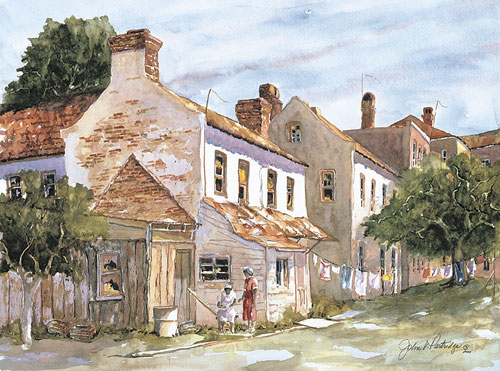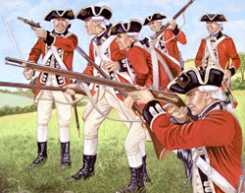
The Fall of Charleston

 |
The Fall of Charleston |
 |
The American Revolutionary War had been fought for four years in the northern states, but after a series of crushing defeats the crowning one at Saratoga, in December, 1778, England decided it was time to bring this war into a new phase. Having no footholds into the New World except at New York and Newport, the British Colonel Campbell commanding 3500 redcoats sailed to Savannah, Georgia where he soundly beat twelve hundred men under General Robert Howe. They took the city, capturing all of its food, weapons, and supplies, while at the same time a large and deeep harbor for British plans in Georgia and the Carolinas. At the time of the fall of Savannah, General Prevost arrived from Florida with more British soldiers. He joined with Campbell and quickly captured Augusta and other smaller Georgian ports and within ten days had all of Georgia under British control.
General Howe was replaced by a man by the name of Benjamin Lincoln, who sent 1500 men south to recapture Savannah. These troops were routed by the British at Briar Creek. Prevost then decided to march northward, and, after endless skirmishes by American troops, and attacks by Casamir Pulaski's legendary cavalry unit he turned back, but not without leaving much destruction in his wake. Thus the first attempt by the redcoats to capture Charleston, the South's principal and largest port, failed.
Hope soon came for the Americans, when a large and powerful French fleet commanded by Admiral Charles Henri d'Estaing arrived from the West Indies. The immediately set out and besieged Savannah with the help of the American army, but British Savannah buckled in and outlasted the siege for three weeks. On October 9, d'Estaing led a disastrous charge on the city. D'Estaing lay wounded and the brave legend Casamir Pulaski died of a mortal wound after the assault. The French fleet retreated because of October gales. This battle, The Battle of Savannah, proved that the British were there to stay.
A few months later, another fleet arrived, but it carried
eight thousand British troops, plus Sir Henry Clinton of New York and Earl Charles Cornwallis. With a combined force of Prevost and his troops,
General Clinton took this army and started for Charleston, which was held by
Lincoln and a force of 7000. Clinton started his siege of the city on April 1,
1780, and on April 8 the British fleet destroyed Fort Moultrie and entered
Charleston harbor. By now, Lincoln should have fled with his army, and left the
doomed city to the British, but he did not. This was a classic example of
European siege tactics, the redcoats drawing ever closer each day to the walls
of the city. Finally, when the British artillery was so close it was setting
many of Charleston's wooden homes on fire, Lincoln surrendered. This surrender
proved to be one of the worst defeats experienced by the Americans in the war,
and at this time American morale was at its lowest. The rebels knew there would
be a long, hard road ahead.
and Earl Charles Cornwallis. With a combined force of Prevost and his troops,
General Clinton took this army and started for Charleston, which was held by
Lincoln and a force of 7000. Clinton started his siege of the city on April 1,
1780, and on April 8 the British fleet destroyed Fort Moultrie and entered
Charleston harbor. By now, Lincoln should have fled with his army, and left the
doomed city to the British, but he did not. This was a classic example of
European siege tactics, the redcoats drawing ever closer each day to the walls
of the city. Finally, when the British artillery was so close it was setting
many of Charleston's wooden homes on fire, Lincoln surrendered. This surrender
proved to be one of the worst defeats experienced by the Americans in the war,
and at this time American morale was at its lowest. The rebels knew there would
be a long, hard road ahead.
Though nearly defeated, South Carolina was not lost, and mainly because of the perseverance and ferocity of the remaining Americans. One of those defenders of liberty was Francis Marion, dubbed the "Swamp Fox," and with a handful of men he relentlessly pounded British supply lines and seemed to disappear in thin air. Another brave American was Thomas Sumter, who used the same guerilla tactics as Marion and who the famous Fort Sumter was named after. Washington by now could raise an army out of Virginia, Maryland, and Delaware, and he favored Nathanael Greene as the army's commander. But the people chose Gates, the hero of Saratoga, and Washington succoumbed to the people. The people should have listened to Washington, because the Americans were crushed in the Battle of Camden. Though they would eventually become victorious at Yorktown, the outlook of the war was grim for the defenders of liberty.
To learn about the Battle of Camden, click here.
To learn about the Battle of Cowpens, click here.